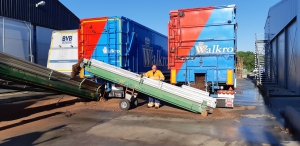Filling and picking organisation.
If you look at this in a glance one might say: the filling has not that much to do with picking. But it is more relevant than many people think. Before the start of picking a first flush, the picking manager makes a plan. When is the room starting? Do I have to pick clusters or pre-runners? How many pickers do I need in this room during lets say 5 days of picking? And an important one, what is the activity of the room? This I need to interact on the growing from day 2 of picking. And this is where the filling of the room comes into the story.
Before the start of picking the picking manager and the grower have a talk about this room. This should start from the moment pins grow out, so about 4 days before the start of picking that room. The picking manager has knowledge about the expected sales that week, the desired size of the mushrooms and the number of pickers available. The grower has knowledge of the room regarding the activity of the compost, the strain and the number of pins developing. An even room is easy to evaluate but if the filling was uneven or two different types of compost were used, than the story gets a bit more difficult. The growing room will develop uneven and one side might start earlier. One side might give more mushrooms and this means that the picking is not the same on all shelves. And with the tendency to build bigger rooms, more trucks of compost are filled in a room. And every truckload of compost can be a bit different. Sometimes in structure, sometimes in moisture content and even in quantity. And every time the operator of the combine filling machine has the desire to change the settings on the machine. Often his order is to get the compost filled. All shelves full and no compost returning to the compost yard or no compost dumped. But by changing the settings the temperature development of the compost will change too. 2 cm deeper fill can result in a difference of a day for the flush to start. It will also have an effect on the number of mushrooms growing out. And during the flush one side will grow faster than the other.
So the general instruction at filling should be not to make any changes. Better a bit of compost left over or a part of the shelves not being filled. An even better way is to fill out of two trucks in one go with a cross conveyor. That way the compost out of two trucks is mixed and differences are ruled out. Another method is to do a mixed fill of the truck at the compost yard. So fill a layer, fill another layer in another truck and then let the trucks circulate. Of course the best possible way is to do the mixed filling of the truck, together with the combined unloading at filling. The growing will be a lot easier then. The grower has a better chance to produce the number of mushrooms required and the picking can be a lot more accurate.
Heavy casing soil, causing problems
The last month several growers had problems with a too heavy casing soil. It is normal for this time of the year for casing soil to be heavier because of rainfall on the peat fields. It takes a few weeks for the casing companies to sort this out and in the mean time the grower has to deal with this. A normal situation for this period. Complaining is not the way to deal with this but inter acting is possible.
The first thing to do is to recognize that the casing ís heavy. This can only be observed if good attention is given to the filling of the room. Always talk to the truck driver about compost and casing and you already know a lot. They know exactly what material they carry. If they say it is a heavy load and if water is coming out the first thing to do is to adjust the filling machine. Heavy casing soil packs more so it has to be opened up. The caccing spinner on the combine filling machine plays a big role in this. It has to pick up the compost and mix it well into the casing. Cac a bit more than normal if casing soil is heavy. The next step is to make the mixing spinner turn a bit slower. Too intensive mixing will destroy the structure and cause big problems in outgrow of the pins later on. The pressing roll should be adjusted that way that it does not close the holes in the casing. If you look at the roller from the side of the shelf, a little bit of light should be visible between roller and casing.
Then be careful with water on the first day. Make sure the caccing material starts growing. This can be seen by the attachment of the compost to the casing. Do not wait however till you really see the mycelium. Because then the time for watering can be too short. And mycelium will overgrow the casing. The normal amount of water can be given minus a few litres. (the water on day one). It is a good thing if watering gifts can be split into small doses. 1 litre at a time with intervals of at least 1 hour. Only on the first watering day (probably day 2 after filling) bigger gifts are possible.
The next thing that might happen is that the mycelium has difficulties growing to the surface. Remember, a heavy casing soil needs help to release water and CO2 so always make sure that fresh air is given to the room. A minimum of 5% fresh air most of the times helps a lot. If the mycelium has reached the surface generally the fructification is normal. The only difference is from day 7 to day 10 of the fructification. From that day 7, the pins might stagger in outgrow. At that moment again fresh air is needed to keep the evaporation going. A minimum of 5% might not be enough anymore. If you see pins but they do not grow out you have a few possibilities.
A drop of water as a shock. This means 0,5 litre of water and mild drying with heating and fresh air. Fan can be set up to 5% higher in speed.
Or you can drop the CO2 to about 1000 ppm for a day. But make sure that RH stays over 88% in this case.Overall the growing later on will be on a bit lower CO2 than normal to keep evaporation going. Watering as normal. The biggest mistake made is to keep rooms like this too dry. Be aware that the room might develop less pins than normal. Let them grow out and pay special attention to the picking. This way these rooms do not have to be any worse. On the contrary, often they are better (in a financial way) than normal.





















